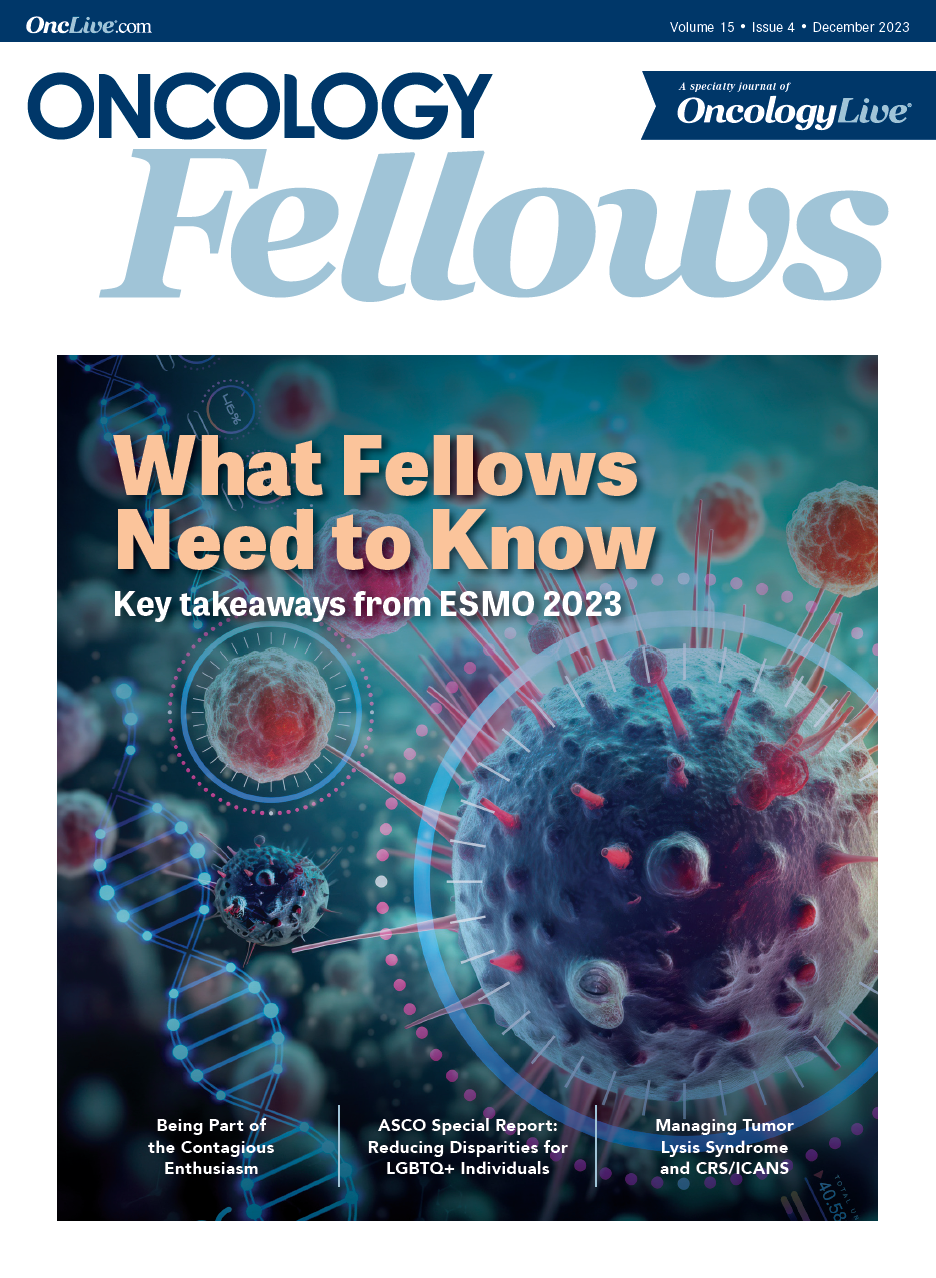ASCO Special Report Outlines Progress in Reducing Cancer Disparities for LGBTQ+ Individuals
Charles S. Kamen, PhD, MPH, discusses key developments and efforts that are planned and underway to further the progress that has been observed in terms of increasing cancer equity in sexual and gender minority individuals.
Charles S. Kamen, PhD, MPH

In a new report, the American Society of Clinical Oncology (ASCO) highlighted progress that has been made toward reducing disparities in cancer health among sexual and gender minority (SGM) individuals, although they stressed that additional progress is still needed in this area.1 The report, which was published in JCO Oncology Practice, served as an update on ASCO’s 2017 position statement “Strategies for Reducing Cancer Health Disparities Among Sexual and Gender Minority Populations.”2
In the 2017 statement, ASCO outlined 5 areas of recommendations aimed at addressing the needs of both SGM patients with cancer and SGM members of the oncology workforce: patient education and support, workforce development and diversity, quality improvement strategies, policy solutions, and research strategies. The authors of the 2023 report noted that significant progress has been made, such as providing recommendations on sexual orientation and gender identity (SOGI) data collection, promoting training focused on SGM disparities in the oncology workforce, supporting research on SOGI data collection, and creating patient support groups and academic resources to serve SGM patients with cancer.1,2
“The [2023] State of Cancer Care in America report was looking at what has been done nationally, and then specifically within ASCO, to address each of these pillars over the past 6 years,” Charles S. Kamen, PhD, MPH, an associate professor of surgery and psychiatry at the University of Rochester Medical Center in New York and cochair of the ASCO Sexual and Gender Minorities Task Force, said. “ASCO convened a task force in 2019 with the specific mission of putting action to the 2017 position statement. Over the past 4 years, we worked to make the pillars of the original vision statement actionable.”
In an interview with Oncology Fellows, Kamen, who is the lead author of the new report, discusses the key developments in this area since 2017 and efforts that are planned and underway to further the progress that has been observed in terms of increasing cancer equity in SGM individuals.
Oncology Fellows: How did you approach this new report and what were some of the key takeaways?
Kamen: When we wrote the manuscript, we reorganized the 5 pillars from how they were in the position statement to emphasize the ones where there had been the most attention given. The first pillar we [addressed] was about quality improvement and data collection. The main priority that many of us have focused on is collecting high-quality sexual orientation and gender identity data consistently across oncology practices for every patient, every time.
You can’t address a problem you can’t see. If you’re not identifying who in your practices are SGM patients, you can never know if they’re having different responses to treatment, are dropping out of treatment at higher rates, are being offered clinical trials at different rates, or if their partners or caregivers are being incorporated into care differently.
This is also the main thing that groups like the National Cancer Institute are focused on. They released a supplement application opportunity last year to help cancer centers [gather] SOGI data consistently. In the [report], we talked about how the task force created an at-a-glance guide for cancer clinical trialists so they can collect SOGI data as part of that work.
What areas still require improvement and how are they being addressed?
One is having a better body of research. There are still so many unanswered questions that SGM patients confront when they’re entering cancer care. For a transgender patient on gender-affirming hormones who is starting chemotherapy or immunotherapy, it’s unclear whether those hormones can continue or if the hormones should be discontinued while they are undergoing cancer treatment. Right now, it is up to oncologist preference on how the patient is counseled, but it would be great to have actual empirical data to support counseling in one direction or another.
We need to think about incorporating SGM identities as part of how people are looking at pipeline issues, who is getting promoted in the oncology workforce, [and] who’s getting supported and mentored in that workforce. Have you made sure that from clinical trial coordinators all the way up to oncologists, there is a workforce that matches the population that’s being served, [for example]?
The last part of our manuscript was [focused on] highlighting policy initiatives. This is the area where we have seen the most backlash to the progress that has been made. We have moved forward in so many areas of this work, and yet there are so many anti-LGBTQ laws on the books in multiple states and more being voted on every day.
We tried to make the point in the paper that we don’t expect oncologists necessarily to go out and lobby for [SGM issues]. However, looking at local policy is important, too. What is the nondiscrimination policy in your oncology practice, and does it include sexual orientation and gender identity as protected categories that should not be discriminated against? That is also useful, and probably even more useful in states where the state-level policies aren’t very welcoming to SGM individuals.
What are some areas of future study you are interested in regarding SGM disparity research?
Intersectionality [remains] a major issue in this field. This is true both for research and for clinical care. We can’t just think about improving care for SGM patients. If you’re coming in to do health equity work, you need to think about multiple intersecting minority identities. [For example], for Black transgender women, are they being served in a cancer care practice with the same high-quality care as a White cisgender male patient?
It’s especially important to think about SGM health equity because there is so much emphasis on it now. [We need to] use this moment of focus to also talk about how practices are treating individuals who are impoverished, have disabilities, are of racial or ethnic minorities, or have language barriers.
How can clinicians use the findings from this report to improve the care they provide?
[They must] figure out a way to assess sexual orientation and gender identity in [their] patients. Patients don’t necessarily want to have a conversation about this topic; there [are] research [data] showing that SGM, heterosexual, and cisgender patients all prefer to respond to questions about sexual orientation and gender identity on a form. [Clinicians need to] figure out a way where they can work with their intake coordinator or the people who run their patient portal and/or medical records so that patients can complete these demographic items nonverbally on a form.
If you’re going to collect the data, you also have to make sure that your care system is equipped to treat those patients with respect and with the same high-quality care as anyone else. An ongoing fear [of ours] is these data will be collected and then individuals who have biases will use it to actually treat SGM patients worse [than other patients], or [that the data] will get into the hands of a “bad actor” and end up causing more distress and more discrimination. That’s [important to consider]—whether that means making sure that [those who work in] the health care system [are] trained to treat SGM patients well or just having protections put in place for who can and can’t access these data.
[Finally], collecting data without action is useless. If you’re going to go through the effort to collect some data, then make sure that [they are] being used in some way to inform the delivery of care. That doesn’t mean that you have to revise the entire procedure for having an oncology visit to account for someone’s sexual orientation or gender identity; there are very simple changes. [These could include] having scripts in your mind so if somebody pushes back against collecting the SOGI data you’re able to say something like, “We ask the same questions of every patient; it’s just for us to get to know you better. If you’re not comfortable answering any of these questions, you don’t have to.” Make it straightforward and simple.
My big-ticket hope from all of this is that we not only start collecting high-quality SOGI data and use [them] to inform care, but also…improve care for everybody because we’ll have these better ways of talking to patients that don’t assume particular relationships or gender identities or expectations. That’s going to help everybody and make care better for every single patient.
References
- Kamen CS, Dizon DS, Fung C, et al. State of cancer care in America: achieving cancer health equity among sexual and gender minority communities. JCO Oncol Prac. 2023;19(11):959-966. doi:10.1200/OP.23.00435
- Griggs J, Maingi S, Blinder V, et al. American Society of Clinical Oncology position statement: strategies for reducing cancer health disparities among sexual and gender minority populations. J Clin Oncol. 2017;35(19):2203-2208. doi:10.1200/JCO.2016.72.0441




